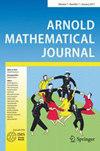具有Newton多面体的多项式映射的性质
Q3 Mathematics
引用次数: 0
摘要
我们讨论了多项式映射\(\varvec{f}:\mathbb{K}^m\rightarrow\mathbb{K}^ n\)、\。我们提出了一种关于\(\varvec{f}\)的牛顿多面体描述\。当\(\varvec{f}\)满足一定条件(1.5)时,我们得到了这样一组\(\varvec{f}\)的显式精确描述。3.在没有条件(1.5)的情况下,描述\(\varvec{f}\)的非真点集的几个技巧也在Sect。5.本文章由计算机程序翻译,如有差异,请以英文原文为准。
Properness of Polynomial Maps with Newton Polyhedra
We discuss the notion of properness of a polynomial map \(\varvec{f}:\mathbb {K}^m\rightarrow \mathbb {K}^n\), \(\mathbb {K}=\mathbb {C}\) or \(\mathbb {R}\), at a point of the target. We present a method to describe the set of non-proper points of \(\varvec{f}\) with respect to Newton polyhedra of \(\varvec{f}\). We obtain an explicit precise description of such a set of \(\varvec{f}\) when \(\varvec{f}\) satisfies certain condition (1.5). A relative version is also given in Sect. 3. Several tricks to describe the set of non-proper points of \(\varvec{f}\) without the condition (1.5) is also given in Sect. 5.
求助全文
通过发布文献求助,成功后即可免费获取论文全文。
去求助
来源期刊

Arnold Mathematical Journal
Mathematics-Mathematics (all)
CiteScore
1.50
自引率
0.00%
发文量
28
期刊介绍:
The Arnold Mathematical Journal publishes interesting and understandable results in all areas of mathematics. The name of the journal is not only a dedication to the memory of Vladimir Arnold (1937 – 2010), one of the most influential mathematicians of the 20th century, but also a declaration that the journal should serve to maintain and promote the scientific style characteristic for Arnold''s best mathematical works. Features of AMJ publications include: Popularity. The journal articles should be accessible to a very wide community of mathematicians. Not only formal definitions necessary for the understanding must be provided but also informal motivations even if the latter are well-known to the experts in the field. Interdisciplinary and multidisciplinary mathematics. AMJ publishes research expositions that connect different mathematical subjects. Connections that are useful in both ways are of particular importance. Multidisciplinary research (even if the disciplines all belong to pure mathematics) is generally hard to evaluate, for this reason, this kind of research is often under-represented in specialized mathematical journals. AMJ will try to compensate for this.Problems, objectives, work in progress. Most scholarly publications present results of a research project in their “final'' form, in which all posed questions are answered. Some open questions and conjectures may be even mentioned, but the very process of mathematical discovery remains hidden. Following Arnold, publications in AMJ will try to unhide this process and made it public by encouraging the authors to include informal discussion of their motivation, possibly unsuccessful lines of attack, experimental data and close by research directions. AMJ publishes well-motivated research problems on a regular basis. Problems do not need to be original; an old problem with a new and exciting motivation is worth re-stating. Following Arnold''s principle, a general formulation is less desirable than the simplest partial case that is still unknown.Being interesting. The most important requirement is that the article be interesting. It does not have to be limited by original research contributions of the author; however, the author''s responsibility is to carefully acknowledge the authorship of all results. Neither does the article need to consist entirely of formal and rigorous arguments. It can contain parts, in which an informal author''s understanding of the overall picture is presented; however, these parts must be clearly indicated.
 求助内容:
求助内容: 应助结果提醒方式:
应助结果提醒方式:


